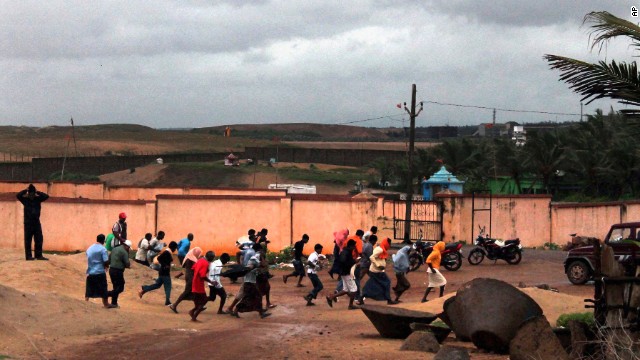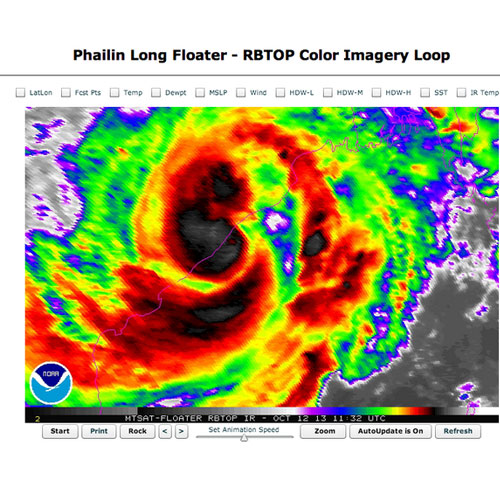Cyclone Phailin on Sunday left a trail of destruction knocking down lakhs of homes affecting nearly 90 lakh people and destroying paddy crops worth about Rs 2,400 crore, but Odisha and Andhra Pradesh escaped from widespread loss of life.
As the largest evacuation efforts in the country's recent history helped keep casualties to the minimum, reports from the two states tonight said that 23 people died, all but two of them in Odisha. Most of the casualties were caused by wall collapse, uprooted trees and in floods.
Communication links were vastly disrupted by the strong winds that went upto a speed of 220 kmph when the "very severe" cyclonic storm crossed the coast near Gopalpur last night and weakened before turning into a depression. Ganjam district in Odisha bore the brunt of the storm.
According to IMD tonight, Phailin weakened further turning into "deep depression" with wind speed of 45-55 kmph and currently lay over northern Chhattisgarh, parts of Orissa and Jharkhand. According to M Mohapatra, scientist (Cyclone Warning Division) of the meteorology department, the "cyclonic storm" has now turned to "deep depression" with the wind speed of 45-55 kmph. It currently lays over northern Chhattisgarh, parts of Orissa and Jharkhand. It is expected to weaken further late tonight, he said.
A Panama-registered cargoship M V Bingo carrying iron ore was reported to have sunk in rough seas in the impact of the cyclone off the coast of West Bengal, but the crew were spotted in a lifeboat by a Coast Guard Dornier aircraft.
Authorities in Odisha evacuated nearly nine lakh people, the largest in recent history, ahead of the storm to cyclone shelters and public buildings like schools to avoid a repeat of the monstrous 1999 super cyclone in which nearly 10,000 people were killed.
"We are on the whole quite satisfied with the type of evacuation that was done," Vice chairman of National Disaster Management Authority M Shashidhar Reddy said. In Gopalpur, where the storm struck first, "almost 90-95% people had been evacuated".
Defence and paramilitary personnel were deployed to carry out relief and rehabilitation measures and restoring infrastructure badly affected by the storm.
The IMD earlier in the day said Phailin has weakened into a cyclonic storm with wind speed between 60 and 70 kmph.
Odisha chief minister Naveen Patnaik said the primary aim was to minimize loss of human lives and they have successfully managed to do so. "Property to the tune of several crores has been damaged...Rehabilitation will now be done."
Giving details of the devastation, Odisha revenue minister S N Patro said 14,514 villages in 12 districts have been affected, hitting a population of 80,53,620.
Over 2.34 lakh houses have been damaged and more than 8.73 lakh people evacuated.
Over five lakh hectares of standing crops have been destroyed by the gushing waters causing an estimated loss of Rs 2,400 crore, he said.
Power situation under control: Power ministry
There were some disturbances in electricity transmission due to cyclone Phailin which struck Odisha and Andhra Pradesh last night, but were attended to in time, the power ministry said.
"Required load and generation were managed in a balanced manner so as to secure stable transmission frequency," it said in a statement.
In Andhra Pradesh, the load was reduced to about 9,000 megawatt (MW) against normal demand of 10,000MW and in Odisha, it was 600MW against the normal demand of 2800MW.
Based on IMD information, extensive prior preparations were undertaken to tackle the effects of cyclone Phailin in the context of power requirements," it said.
Advance preparations were made to manage generation and load balance for unhindered and secure grid operation. Power stations in the region were also monitored, it further added.
As required load and generation were managed in a balanced manner so as to secure stable transmission frequency.
Also three Emergency Restoration Systems (ERS) of PGCIL were put on standby readiness in AP and Odisha for quick deployment in the event of damage.
The National Load Dispatch Centre under the control of POSOCO was operating 24 hrs and in touch with the regional dispatch centres of POSOCO and the state load dispatch centre (SLDC).
A high level team headed by additional secretary in the ministry was coordinating all the steps required including 2 hourly reports to all concerned, the statement further added.














